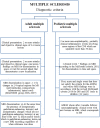Multiple Sclerosis in Pediatrics: Current Concepts and Treatment Options
- PMID: 27640189
- PMCID: PMC5130919
- DOI: 10.1007/s40120-016-0052-6
Multiple Sclerosis in Pediatrics: Current Concepts and Treatment Options
Abstract
Multiple sclerosis (MS) is a chronic, autoimmune, inflammatory, demyelinating disease of the central nervous system. MS is increasingly recognized in the pediatric population, and it is usually diagnosed around 15 years of age. The exact etiology of MS is still not known, although autoimmune, genetic, and environmental factors play important roles in its development, making it a multifactorial disease. The disease in children almost always presents in the relapsing-remittent form. The therapy involves treatment of relapses, and immunomodulatory and symptomatic treatment. The treatment of children with MS has to be multidisciplinary and include pediatric neurologists, ophthalmologists, psychologists, physiotherapists, and if necessary, pediatric psychiatrists and pharmacologists. The basis of MS therapy should rely on drugs that are able to modify the course of the disease, i.e. immunomodulatory drugs. These drugs can be subdivided into two general categories: first-line immunomodulatory therapy (interferon beta-1a, interferon beta-1b, glatiramer acetate) and second-line immunomodulatory therapy (natalizumab, mitoxantrone, fingolimod, teriflunomide, azathioprine, rituximab, dimethyl fumarate, daclizumab). Treatment of relapses involves the use of high intravenous doses of corticosteroids, administration of intravenous immunoglobulins, and plasmapheresis. We summarize here the current available information related to the etiology and treatment options in MS. Early administration of immunomodulatory therapy is beneficial in adults, while more studies are needed to prove their effectiveness in pediatric populations. Therefore, pediatric MS still represents a great challenge for both, the early and correct diagnosis, as well as its treatment.
Keywords: Etiology; Immunomodulatory therapy; Multiple sclerosis; Pediatrics; Treatment.
Figures
References
-
- Orrell RW. Multiple sclerosis: the history of a disease. J R Soc Med. 2005;98(6):289. doi: 10.1258/jrsm.98.6.289. - DOI
Publication types
Grants and funding
LinkOut - more resources
Full Text Sources
Other Literature Sources



